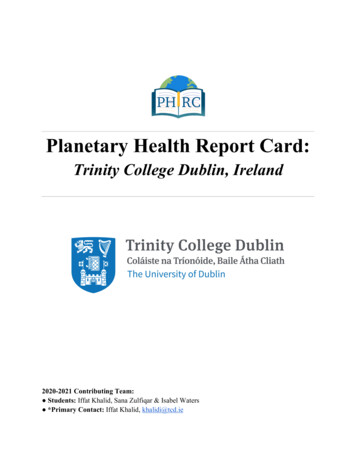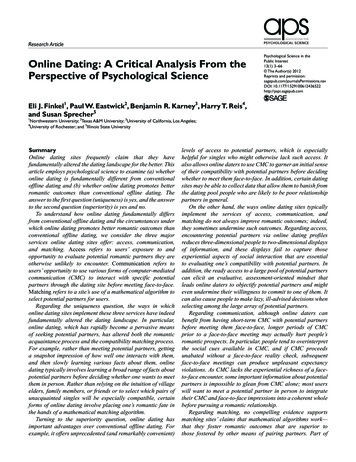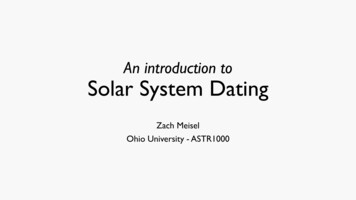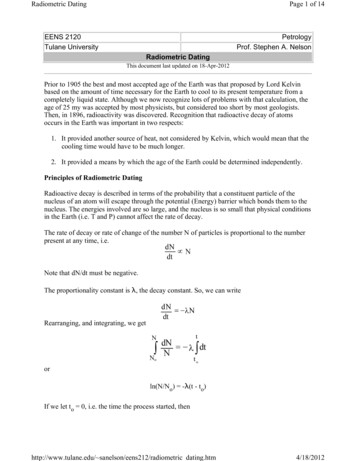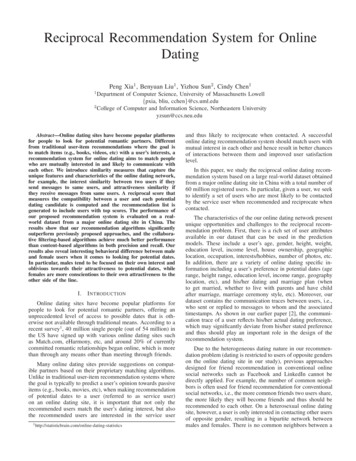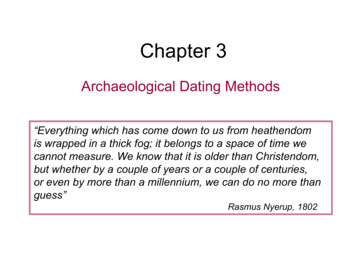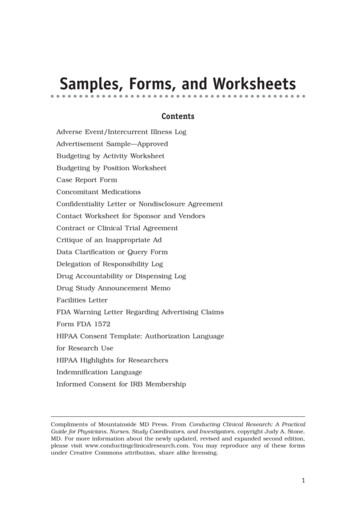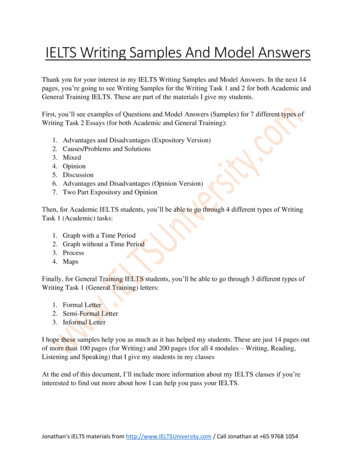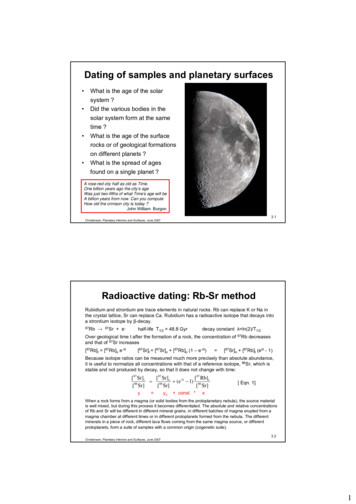
Transcription
Dating of samples and planetary surfaces What is the age of the solarsystem ?Did the various bodies in thesolar system form at the sametime ?What is the age of the surfacerocks or of geological formationson different planets ?What is the spread of agesfound on a single planet ?A rose-red city half as old as Time.One billion years ago the city‘s ageWas just two-fifths of what Time‘s age will beA billion years from now. Can you computeHow old the crimson city is today ?John William Burgon3.1Christensen, Planetary Interiors and Surfaces, June 2007Radioactive dating: Rb-Sr methodRubidium and strontium are trace elements in natural rocks. Rb can replace K or Na inthe crystal lattice, Sr can replace Ca. Rubidium has a radioactive isotope that decays intoa strontium isotope by β-decay.87Rb 87Sr e-half-life T1/2 48.8 Gyrdecay constant λ ln(2)/T1/2Over geological time t after the formation of a rock, the concentration of 87Rb decreasesand that of 87Sr increases[87Rb]t [87Rb]o e-λt[87Sr]t [87Sr]o [87Rb]o (1 – e-λt) [87Sr]o [87Rb]t (eλt - 1)Because isotope ratios can be measured much more precisely than absolute abundance,it is useful to normalize all concentrations with that of a reference isotope, 86Sr, which isstable and not produced by decay, so that it does not change with time:[87 Sr]t[87 Sr][87 Rb] 86 o (eλt 1) 86 t86[ Sr][ Sr][ Sr]y yo const *[ Eqn. 1]xWhen a rock forms from a magma (or solid bodies from the protoplanetary nebula), the source materialis well mixed, but during this process it becomes differentiated. The absolute and relative concentrationsof Rb and Sr will be different in different mineral grains, in different batches of magma erupted from amagma chamber at different times or in different protoplanets formed from the nebula. The differentminerals in a piece of rock, different lava flows coming from the same magma source, or differentprotoplanets, form a suite of samples with a common origin (cogenetic suite).Christensen, Planetary Interiors and Surfaces, June 20073.21
Rb-Sr methodBecause the different isotopes of anelement behave chemically almostidentically, different samples of a suite mayhave different concentrations of Sr and Rb,but their isotope ratios are initially the same.As time progresses, the 87Sr/86Sr-ratio willgrow strongly in a sample with a high Rb/Srratio and weakly in a sample with a lowRb/Sr-ratio.[87 Sr][86 Sr]t2 t1t 0[87Rb]/[86Sr]The age is obtained by measuring theisotope ratios of several samples of a suiteand by calculating the best-fitting linearregression to eqn. 1 on slide 3.2. With theknown value of λ the age is obtained fromthe constant of proportionality (the slope ofthe regression line, called isochron). Animportant condition is that the differentsamples formed closed systems, i.e. therewas no chemical exchange with theenvironment after their formation.Rb-Sr-isochronof a chondrite3.3Christensen, Planetary Interiors and Surfaces, June 2007Dating a second step of differentiationt2[87 Sr][86 Sr] t1 t 0[87Rb]/[86Sr]At t 0 a reservoir (e.g. protosolar nebula) splits up into several bodies (planets). At a latertime t1 the red one differentiates into different sub-samples (yellow, red and pink) withdifferent Rb/Sr-ratios. Their 87Sr/86Sr ratio is the same at t1, because they are all drawn fromthe same reservoir. However, subsequently it will evolve differently because of the differentRb concentrations. The slope connecting these three samples at t2 indicates the time lapsebetween t1 and t2, i.e., the age of the second differention event. When we want to use thesamples from the „red planet“ in order to date the first event, we must „remix“ them and usethem together with data from the other planets (blue and black). If we used at t2 the blue,yellow and black points, they do not fall on a straight line.Christensen, Planetary Interiors and Surfaces, June 20073.42
Pb-Pb methodThe lead-lead method of dating makes use of two decay series, both starting at an isotopeof uranium and ending at a lead isotope.238U . 206Pb (T1/2 4.46 Gyr)235U . 207Pb (T1/2 0.704 Gyr) [ 206 Pb] [206 Pb][207 Pb]t[207 Pb]eλ235t 1 [235 U]t 204 t 204 0 204 0 λ238t238204[ Pb][ Pb] e 1 [ U]t [ Pb] [ Pb]y R [235U]/[238U] 1/137.9yo const(today)At a given time, R is the same for allsamples. Because of the short half-life of235U, the 207Pb/204Pb-ratio grew rapidlyearly on, but grows more slowly in morerecent times. Again, samples from acogenetic suite fall on an isochron,whose slope relates to the age througheqn. 2. With this method only isotopesratios of a single element need to bemeasured.*(x- [Eqn. 2]xo)[ 207 Pb][ 204 Sr]t1t2highU/Pb ratiolowU/Pb ratiot 0[206Pb]/[204Pb]3.5Christensen, Planetary Interiors and Surfaces, June 2007Age of meteorite parent bodiesAge 4.55 GyrPb-Pb isochrone of meteorites ofdifferent types. Canyon Diablo isan iron meteorite containing Pb butalmost no U. The point for Earth isobtained from a mixture of riversediments.Most meteorites (of various types) fall on a single Pb-Pb isochron. A representativemixture of terrestrial rocks falls on the same line. The various meteorite parent bodies andthe Earth (or the protoplanets that built the Earth) formed at the same time. The age of theisochron, 4.55 Gyr, is taken as the time of formation of the entire solar system.It marks the time when the different bodies in the solar system separated, with no orvery limited chemical exchange between them thereafter.Christensen, Planetary Interiors and Surfaces, June 20073.63
Radioactive dating of individualsamples from the solar systemSome parts of a body in the solar system can be younger than the body as a whole. Forexample, an individual rock on Earth is younger than the Earth, because after formationthe Earth continued to differentiate internally. The age of the individual sample is obtainedby dividing it up into sub-samples (e.g. into the various minerals forming a rock) anddetermine an isochron for this suite. The following characteristic ages are obtained usingdifferent radioactive dating techniques:Chondritic / iron meteorites:4.55 GyrHED meteorites (Vesta ?)4.5 GyrOldest terrestrial mineral grains (zircons):4.4 GyrOldest terrestrial rocks:4.0 GyrLunar highland rocks:4.5 – 3.9 GyrLunar Mare rocks:3.9 – 3.1 GyrSNC meteorites (Mars?)4.3 – 0.2 GyrAverage terrestrial continental crust: 2.5 GyrTerrestrial oceanic crust:0.0 – 0.2 Gyr3.7Christensen, Planetary Interiors and Surfaces, June 2007High resolution dating of early eventsShort-lived (now extinct) radioactiveisotopes were present when the solarsystem formed. Example:26Al 26Mg e-T1/2 720,000 yr.In so-called calcium-aluminium richinclusions (CAIs) in the chondritic Allendemeteorite, the ratio [26Mg]/[24Mg] correlateslinearly with the Al/Mg-ratio. It shows that26Al was incorporated into the CAIs andcreated by decay of the excess 26Mg.Conclusions(1)(2)[27Al]/[24Mg]CAIs represent the first condensation products in the solar nebula, which were laterincluded into chondritic meteorites,The nucleosynthesis, which created some of the heavy elements of which the terrestrialplanets are formed, occured not more than a few Myr before the solar system formed(otherwise 26Al would have no longer been present). Perhaps a supernova explosionoccured 5 Myr before the CAIs condensed, blowing heavy elements (among them 26Al)into space, triggering at the same time the gravitational collapse of the protosolar gascloud.Christensen, Planetary Interiors and Surfaces, June 20073.84
Surface ages from cratering statisticsCumulative # of craters D per km21 Orientale2 Erathostenes3 CopernicusLunar near sideAll solar system bodies a subject to a continuousflux of impactors. On most planets erosion is muchless active than on Earth and impact craters survivefor billions of years, unless the planetary surface ischanged by internal processes (volcanism). Thecrater density of a geological unit allows to date it,at least in a relative sense.3.9Christensen, Planetary Interiors and Surfaces, June 2007Radiometrically dated samples from themoon allow to associate an absolute agewith a certain crater density. The relationis non-linear because the flux of impactorswas higher before 3.5 Gyr, but seems tostay at a nearly constant level since.With this calibration, absolute ages havebeen determined also for other planetarysurfaces from the crater density. However,a correction for the different fluxes ofimpactors in different parts of the solarsystem must be made (based ontheoretical considerations), which adds tothe uncertainty.The uncertainty is probably a factor of twofor young ages ( 1 Gyr), but relativelyless for old ages because of the variationof impactor flux between 4.5 and 3.5 Gyr.Christensen, Planetary Interiors and Surfaces, June 2007Crater density / km2 normalized for D 1 kmCratering density versus age3.105
Example: Cratering density ages on Mars20 kmPart of OlympusMons calderaSouthern Highlands: 3.8 GyrLarge volcanoes: mostly 3 -1 GyrNorthern Lowlands: 3.0 GyrOlympus Mons caldera: 100-200 Myr, somesmall flank regions 4 Myr (HRSC camera!)3.11Christensen, Planetary Interiors and Surfaces, June 2007Example: Crater density on VenusPristine impact craterOnly large impactors can penetrate the dense atmosphere of Venus: no small craters, limited statistics.Approximately 1000 impact craters identified on MagellanModified impact craterradar images. Their distribution is uniform: all parts of theVenusian surface seem to have the same age (very different from Earth!). Theirdensity requires an age of 600 200 Myr (young for a planetary surface!). Itseems that a relatively short, global event re-surfaced Venus at this time.Christensen, Planetary Interiors and Surfaces, June 20073.126
FrequencySurface ages for different planetsVenusMoonEarth?Mars4321Age [Gyr]0Schematic age frequency distribution of surface units on the terrestrial planetsChristensen, Planetary Interiors and Surfaces, June 20073.137
Radioactive dating of individual samples from the solar system Christensen, Planetary Interiors and Surfaces, June 2007 3.8 Short-lived (now extinct) radioactive isotopes were present when the solar system formed. Example: 26Al 26Mg e-T 1/2 720,000 yr. In so-called calcium-aluminium rich inclusions (CAIs) in the chondritic Allende
